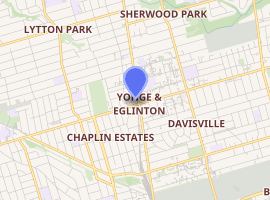Canada Square Complex
Canada Square is a complex of three interconnected office buildings located at Yonge and Eglinton in Toronto, Ontario, Canada, including a small shopping concourse and a multiplex cinema. The two main towers are examples of International Style.
The complex's largest tenant is Canadian Tire, which has its corporate offices in two of the buildings (it is not a retail location).
Buildings
2200 Yonge Street
| 2200 Yonge Street | |
|---|---|

| |
| Alternative names | Foundation House |
| General information | |
| Type | Commercial offices |
| Location | Toronto, Ontario |
| Completed | 1962 |
| Height | |
| Top floor | 17 |
| Technical details | |
| Floor count | 17 |
| Floor area | 259,397 square feet (24,099 m2) |
| Design and construction | |
| Architect | Kenneth R. Cooper |
2200 Yonge Street is located directly above the Toronto Transit Commission's Eglinton station and has connecting passages to the station as well as to the Yonge Eglinton Centre across the street. The YMCA of Greater Toronto and UNICEF Canada are also headquartered there.
2190 Yonge Street
2190 Yonge Street was built in 1987 with 6 floors and 151,021 square feet (14,030 m2) of space.
Major tenants:
2180 Yonge Street
| 2180 Yonge Street | |
|---|---|

| |
| Alternative names | Canadian Tire Building |
| General information | |
| Type | Commercial offices |
| Location | Toronto, Ontario |
| Completed | 1972 |
| Height | |
| Top floor | 18 |
| Technical details | |
| Floor count | 18 |
| Floor area | 402,277 square feet (37,373 m2) |
| Design and construction | |
| Architect | Kenneth R. Cooper |
2180 Yonge's major tenants include:
- Canadian Tire Head Office
- TVO and TFO - Ontario's education television stations (English and French)
- Independent Learning Centre